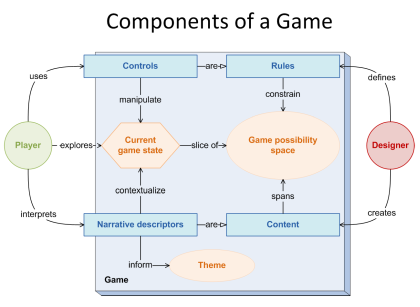It has just dawned on me that I have never published my diagram illustrating the structural composition of games as interactive systems. I have originally put it together for the presentation of my seminar paper on Journey and semiotics (my slides can never be published because they contained way too many copyrighted pictures) and got very positive feedback on it, but it had not occurred to me until now to make it publicly available. I will also take this opportunity to explain the very low-level terms I use to talk about games and how they relate to each other.
Games of any kind (social, tabletop, computer, etc.) are systems, meaning that they consist of multiple interacting parts. Games-as-systems are furthermore...
- ...interactive, meaning that they exist in a feedback loop with at least one human operator ("player"),
- ...engineered, meaning that they are created by human designers for a particular purpose (usually to entertain players), and
- ...heterogeneous, meaning that they consist of parts of different kinds, such as rules and content.
With this in mind, we proceed to outline additional basic definitions:
- A designer is any person who participates in the creation of a game, whether by designing its systems, creating artwork and other assets, writing code, etc.
- A player is any person who interacts with a game's content and rules, their end user and audience.
- Content encompasses all parts that make up the game: board, cards, tokens, etc. for tabletop games; images, audio files, texts, etc. for video games.
- Rules are specifications of how individual pieces of content can behave and interact.
- Controls are a subset of rules that specify how a player can manipulate the game state.
- Narrative descriptors are a subset of content that is exposed to the player, to be interpreted as semiotic signs.
Both rules and controls are referred as "mechanics" by different sources, which is why I prefer these less ambiguous terms. The term "narrative descriptor" was, to my knowledge, coined by Salen and Zimmerman. Using these basic concepts, we can derive more abstract and esoteric ones:
- Together, a game's content and rules create its possibility space: a combinatorial set of all possible permutations of its content that comply with its rules. The possibility space of chess, for example, consists of every arrangement of pieces on the board that can ever be reached from the starting position through legal moves. The designer creates the content to span a game's possibility space and defines rules to constrain it.
- The game state is a slice of its possibility space: a specific instantiation of a set of variables that completely describes the system's internal conditions at any given point in time (turn, frame, etc.), even those not apparent to a player. A chess diagram and a save file both contain a game state. A player uses the controls to explore and to manipulate the current game state, also learning the overall shape of the game's possibility space in the process.
All narrative descriptors of a game together shape its theme (a term used here as in Burgun 2014, rather than in its more literary sense; it is alternatively referred as "conceit" and "motif" in some sources): the core metaphor attached to the game-as-system in order to communicate abstract rules via symbols that a player can interpret (in the semiotic sense). Narrative descriptors thus provide context to the player's interactions with a game by associating them with real life experiences, such as a humanoid bitmap representing a human being.
All of the player's (controls-mediated) interactions with the game state comprise the gameplay, while gameplay and theme together facilitate the core fantasy of the game (see Portnow and Floyd 2016, Costiuc 2019, etc.). These concepts didn't fit into the diagram because they emerge from the usage of the system, rather than its constituent parts, but I think it's nonetheless important to point out how they fit into the overall picture.




